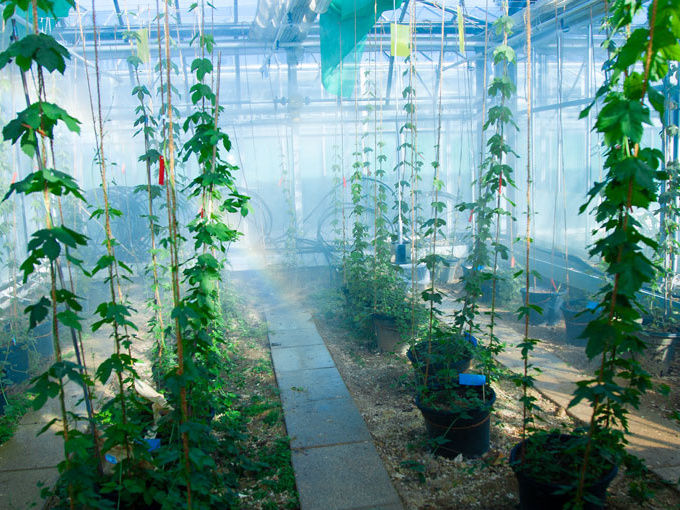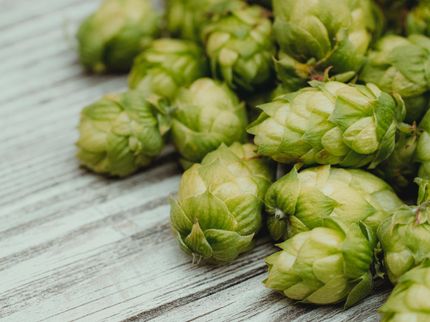Beer in danger
Supermarket citrus fruits contain hop pathogens
Incorrect disposal of fruit residues could transfer viroids from citrus fruits to hops and potentially endanger beer supplies - according to a study by the University of Hohenheim.

Citrus fruits from the grocery store contain hop pathogens, according to a study by the University of Hohenheim.|
Universität Hohenheim / Astrid Untermann
Hops, Germany's green gold, are under threat: the Citrus Bark Cracking Viroid (CBCVd) is spreading. This is because when these pathogens get into hop plants, yield losses are the result. They come via infected planting material or from imported citrus fruit, revealed a study by Dr. Michael Hagemann of the University of Hohenheim in Stuttgart. New infections can be triggered by careless handling of leftover citrus fruit in hop-growing areas. Conscious handling of these factors could mean salvation for hop production.
They are a magnificent sight: Hop plants climb up to eight meters high with their fragrant cones on wire-rope racks. They can be found not only in the Bavarian Hallertau region - the largest hop-growing area in the world with around 17,000 hectares - but also on around 1,500 hectares in the Upper Swabian town of Tettnang and in the Elbe-Saale, Spalt and Bitburg hop-growing regions. Germany produces over a third of the world's hop harvest.
But the "green gold" is threatened - not only by climate change, whose influence was the focus of media attention during this year's hop harvest. Dangerous pathogens could also cause problems in the future: "The Citrus Bark Cracking Viroid (CBCVd) was surprisingly detected in German hops in 2019," reports Dr. Michael Hagemann from the Specialty Crops Production Systems department at the University of Hohenheim.
Yield losses due to infestation with viroids
Viroids, which unlike viruses do not have a protein coat, are in a sense miniature parasites. They use the proteins of their host cell for their own functions and use the plant cells to reproduce. This can cause problems for the host plants.
CBCVd usually occurs in citrus without symptoms or, in a few cultivars, leads to rupture of the bark, the eponymous bark cracking. Bark cracking also occurs when the viroid infects hop plants, but more importantly it causes gradual upsetting. This only becomes visible after 1-2 years and leads to plant death in subsequent years. "The hop plants remain smaller, growing to 5-6 meters instead of the usual 8 meters. This process is initially invisible to the naked eye and requires molecular biology tests for diagnosis," the expert explains. "Infested plants have smaller umbels and less bitter substances important for brewing beer, and later dieback follows."
Spread by improperly disposed of citrus....
Dr. Hagemann and his colleagues investigated how the viroids get into the hop plants. Their suspicions were confirmed: About six percent of supermarket-grown citrus contains CBCVd, and the researchers were also able to detect other viroids in the fruit. The team examined nearly 400 samples from grocery stores in hop-growing regions of Germany and 50 from Slovenia - and found up to five different viroids in goods from all the citrus-growing countries sampled.
The good news is that conscious handling of fruit can help contain the spread of viroids. "Careless disposal of fruit residues in agricultural areas can promote the spread of these diseases," Dr. Hagemann cautions. "Therefore, the rule is especially true in hop-growing areas: Please do not simply throw citrus fruits or peels anywhere while walking or working in the fields. The panicles of grapes can also contain harmful viroids of hops. And leftovers from the farmer's market should be properly composted to avoid transfer to hops."
...and by using viroids as an upsetting agent in citrus production.
The researchers have also identified another problem that contributes to the spread of viroids: "In citrus cultivation, viroids are used specifically as a so-called compressive agent. Infested trees remain smaller and are thus easier to maintain and harvest," explains Dr. Hagemann. "But in view of the serious threat to hop production, we urgently plead that they should no longer be used, nor should they be recommended in advisory services."
Dr. Hagemann sees a lot of research still needed in this area. In his field, doctoral student Swati Jagani is also researching the question of whether viroids can be transmitted by citrus-based crop protection products.
High number of unreported cases of infestation
"In Bavaria, more than 110 hectares of hop acreage are already affected by CBCVd, and there is probably a high number of unreported cases," explains Dr. Hagemann. In hop-growing areas, propagation by infected planting material - so-called fenchers - and pruning measures also favor the spread of the viroids.
"To contain the spread, when an infestation is detected, not only the infected plant but also some plants before and after it are removed, and regular tests are carried out in the affected area," Dr. Hagemann said. "In the case of an infestation, a fallow or crop rotation of two years is also strongly advised."
Incidentally, the viroids tested are not dangerous to humans, Dr. Hagemann reassures: "So far, there is no evidence that CBCVd or other viroids in the affected fruit pose a risk to human health."
Note: This article has been translated using a computer system without human intervention. LUMITOS offers these automatic translations to present a wider range of current news. Since this article has been translated with automatic translation, it is possible that it contains errors in vocabulary, syntax or grammar. The original article in German can be found here.





























































